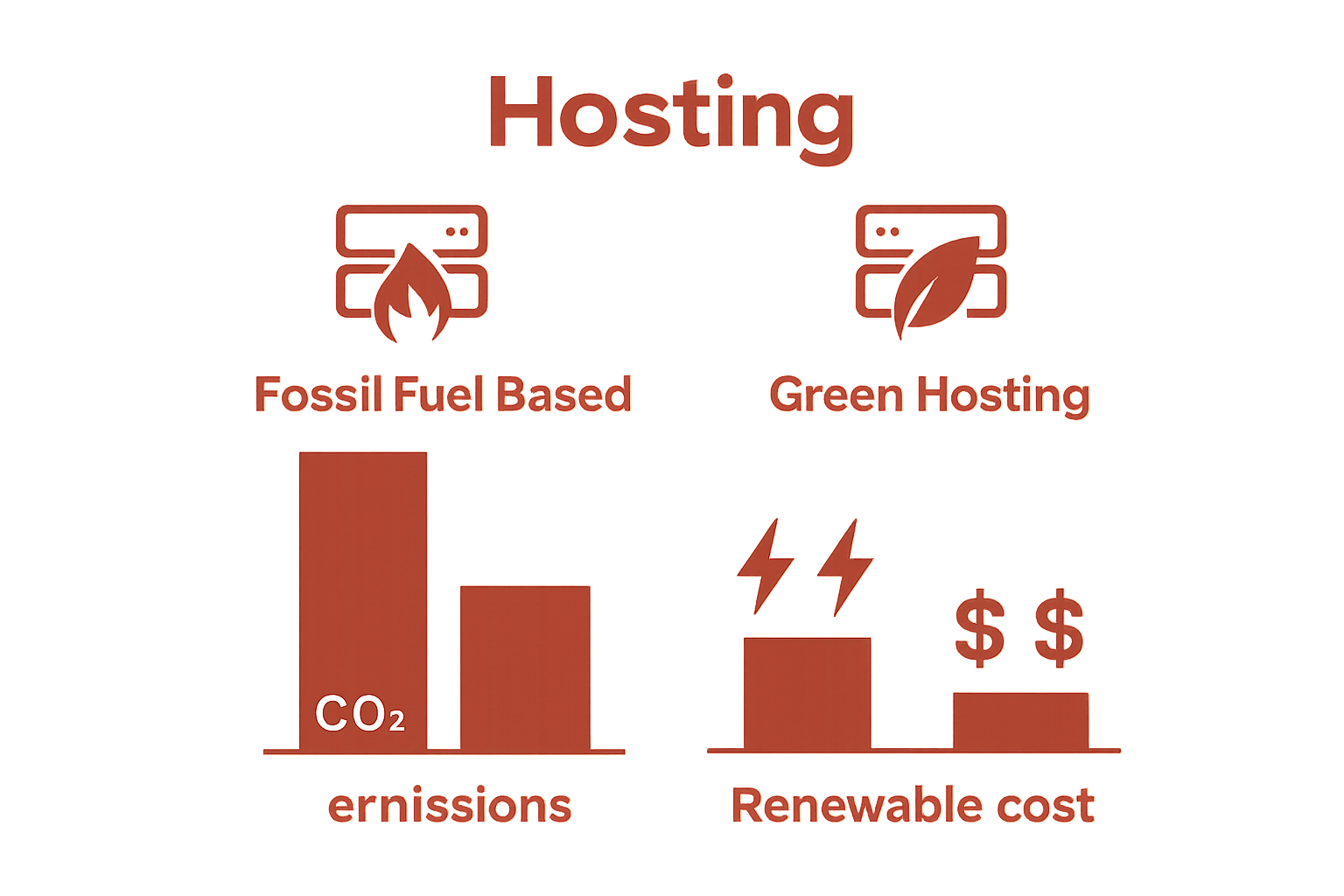Understanding Why Choose Green Hosting for Your Website
Websites run quietly from data centres all over the world, but they leave a surprisingly large mark on the environment. Data centres use about 1% of the world’s electricity and this figure keeps rising. While most people think websites are clean and intangible, their carbon footprint rivals major industries. The real shock is this: switching to green hosting can slash those emissions by up to 50% and hardly anyone realises how much power their online presence truly uses.
Table of Contents
- Defining Green Hosting And Its Core Principles
- The Importance Of Sustainable Web Hosting Solutions
- How Green Hosting Works: Energy Sources And Efficiency
- Comparing Traditional Hosting And Green Hosting Models
- Real-World Impact: Environmental Benefits Of Green Hosting
Quick Summary
| Takeaway | Explanation |
|---|---|
| Green hosting reduces carbon emissions significantly. | By utilising renewable energy sources, green hosting can lower carbon emissions by up to 50% compared to conventional hosting methods. |
| Choose providers prioritising renewable energy. | Evaluate hosting services based on their commitment to using renewable energy like solar and wind to power data centres. |
| Energy-efficient technologies enhance performance. | Green hosting incorporates advanced technologies that optimise energy use, improving operational efficiency without compromising website performance. |
| Sustainable hosting offers economic advantages. | Transitioning to green hosting can lead to lower energy costs, potential tax benefits, and an enhanced brand reputation among eco-conscious consumers. |
| Corporate responsibility is crucial in hosting decisions. | Opting for green hosting signals a company’s commitment to environmental stewardship, which can improve stakeholder perceptions and align with sustainability goals. |
Defining Green Hosting and Its Core Principles
Green hosting represents an environmentally conscious approach to web infrastructure, focusing on minimising the carbon footprint of digital services. Unlike traditional web hosting, green hosting prioritises sustainable practices that reduce energy consumption and environmental impact.
Understanding the Environmental Impact of Web Hosting
Web hosting traditionally relies on data centres consuming substantial electricity, predominantly generated from non-renewable sources. Global Energy Research Institute suggests that data centres contribute approximately 1% of global electricity demand, with projections indicating significant growth.
The environmental burden stems from multiple factors:
- Continuous power requirements for server operations
- Extensive cooling systems maintaining optimal temperatures
- Carbon emissions from electricity generation
- Electronic waste from hardware replacement
Core Principles of Green Web Hosting
Green hosting operates on fundamental sustainability principles designed to minimise ecological consequences. These principles encompass:
- Utilising renewable energy sources like solar and wind power
- Implementing energy-efficient server technologies
- Purchasing verified carbon offset credits
- Investing in sustainable infrastructure
How Green Hosting Works
Green web hosting providers strategically select data centre locations with access to renewable energy, invest in energy-efficient hardware, and implement advanced cooling technologies.
VIDEO:video_content] [Sustainable Computing Research Centre highlights that modern green hosting can reduce carbon emissions by up to 50% compared to traditional hosting models.
By choosing green hosting, website owners contribute directly to reducing digital infrastructure’s environmental impact while maintaining robust online performance.
The following table summarises the core principles and sustainable features that define green hosting as highlighted in the article.
| Principle or Feature | Description |
|---|---|
| Use of Renewable Energy | Data centres powered by solar, wind, and hydroelectric sources |
| Energy-Efficient Technologies | Implements advanced server hardware and smart management systems |
| Carbon Offset Programmes | Invests in projects to counterbalance remaining emissions |
| Sustainable Infrastructure | Ongoing commitment to eco-friendly development and facility management |
| Advanced Cooling Solutions | Employs natural or highly efficient cooling methods to reduce energy consumption |
| Transparent Carbon Management | Open about energy mix and environmental impact |
The Importance of Sustainable Web Hosting Solutions
Sustainable web hosting solutions are becoming increasingly critical in addressing global environmental challenges. By recognising the substantial carbon footprint associated with digital infrastructure, businesses and individuals can make meaningful contributions towards reducing ecological impact.
Economic and Environmental Benefits
Choosing green hosting is not merely an environmental statement but a strategic decision with wide-reaching implications. Climate Neutral Group reports that sustainable digital practices can significantly reduce operational carbon emissions while potentially lowering long-term hosting expenses.
The economic advantages of sustainable hosting include:
- Reduced energy consumption costs
- Potential tax incentives for green technology adoption
- Enhanced brand reputation among environmentally conscious consumers
- Long-term operational efficiency
Climate Impact of Digital Infrastructure
Digital technologies contribute substantially to global carbon emissions. Server farms and data centres consume enormous quantities of electricity, with International Energy Agency research indicating that global data centre electricity consumption could reach 1,200 TWh by 2030.
By selecting sustainable web design solutions, organisations can directly mitigate these environmental challenges and demonstrate corporate responsibility.
Practical Considerations for Sustainable Hosting
Implementing sustainable hosting requires a holistic approach. Website owners should evaluate hosting providers based on their commitment to renewable energy, energy efficiency, and transparent carbon management strategies.
Key selection criteria include:
- Percentage of renewable energy in their power mix
- Carbon offset programmes
- Energy-efficient server technologies
- Commitment to sustainable infrastructure development
Ultimately, sustainable web hosting represents a powerful mechanism for reducing digital environmental impact while maintaining robust online performance.
How Green Hosting Works: Energy Sources and Efficiency
Green hosting transforms digital infrastructure by integrating innovative technologies and sustainable energy strategies that dramatically reduce environmental impact. By reimagining traditional data centre operations, these solutions create a more responsible approach to web hosting.
Renewable Energy Integration
Green hosting providers strategically leverage renewable energy sources to power their data centres. Solar, wind, and hydroelectric power form the cornerstone of sustainable digital infrastructure. Scientific Research on Sustainable Computing indicates that comprehensive renewable energy strategies can reduce carbon emissions by up to 80% compared to conventional hosting models.
Key renewable energy approaches include:
- Direct power purchase from wind and solar farms
- On-site renewable energy generation
- Long-term renewable energy contracts
- Investment in green energy infrastructure
Energy Efficiency Technologies
Beyond renewable energy, green hosting employs advanced technologies to minimise energy consumption. Intelligent server management systems optimise computational resources, reducing unnecessary power drain and improving overall efficiency.
Efficiency technologies encompass:
- Virtualisation techniques reducing physical server requirements
- Advanced cooling systems using natural temperature regulation
- High-efficiency server hardware
- Smart power management algorithms
Carbon Neutrality and Offset Strategies
When complete renewable energy transition remains challenging, green hosting providers implement comprehensive carbon offset programmes. These strategies involve investing in environmental projects that counterbalance remaining carbon emissions.
By exploring sustainable web design solutions, organisations can actively participate in reducing digital environmental footprints. Green hosting represents more than a technological choice it is a commitment to responsible digital infrastructure that balances technological progress with environmental stewardship.
Comparing Traditional Hosting and Green Hosting Models
Traditional and green hosting models represent fundamentally different approaches to web infrastructure, with significant variations in environmental impact, operational strategies, and long-term sustainability considerations.
Energy Consumption and Carbon Footprint
Traditional hosting models predominantly rely on grid electricity, typically generated from fossil fuel sources. Renewable Energy Research indicates that conventional data centres generate substantial carbon emissions through inefficient energy practices.
Key differences in energy consumption include:
- Fossil fuel dependency in traditional models
- High electricity consumption without efficiency optimisation
- Limited investment in renewable energy infrastructure
- Minimal carbon offset strategies
Technological Infrastructure and Efficiency
Green hosting models integrate advanced technologies designed to minimise environmental impact. Unlike traditional hosting, these solutions prioritise energy efficiency and computational resource optimisation.
Technological distinctions encompass:
- Intelligent server management systems
- Advanced virtualisation techniques
- Renewable energy-powered infrastructure
- Comprehensive energy monitoring protocols
Cost and Performance Considerations
Contrary to common misconceptions, green hosting does not compromise performance. By exploring sustainable web design solutions, organisations can achieve robust digital infrastructure while reducing ecological footprints.
Economic advantages of green hosting include:

- Potential long-term cost savings
- Enhanced brand reputation
- Reduced operational energy expenses
- Alignment with emerging environmental regulations
Ultimately, the transition from traditional to green hosting represents a strategic investment in sustainable digital infrastructure, balancing technological performance with environmental responsibility.
To aid understanding of the key distinctions, the table below compares the main features and outcomes of traditional versus green hosting models discussed in the article.
| Aspect | Traditional Hosting | Green Hosting |
|---|---|---|
| Main Energy Source | Grid electricity (mainly fossil fuels) | Renewable energy (solar, wind, hydro) |
| Energy Efficiency | Limited; inefficient power practices | High; advanced efficiency technologies |
| Carbon Footprint | High, with substantial emissions | Reduced, with up to 50-80% lower emissions |
| Use of Carbon Offsets | Minimal or none | Frequent; supports environmental projects |
| Technological Infrastructure | Standard server tech, little optimisation | Efficient hardware, intelligent management |
| Cost Considerations | Traditionally lower up front, but rising | Long-term savings, tax benefits possible |
| Brand Reputation Impact | Neutral or negative for eco-conscious users | Enhanced among environmentally aware consumers |
Real-World Impact: Environmental Benefits of Green Hosting
Green hosting transcends theoretical environmental concepts, delivering tangible and measurable ecological benefits that directly contribute to global sustainability efforts. By transforming digital infrastructure, organisations can create meaningful environmental change through strategic technological choices.
Quantifiable Carbon Reduction
Sustainable web hosting generates substantial carbon emission reductions. International Climate Research Institute highlights that digital infrastructure transformation can significantly mitigate greenhouse gas emissions, with green hosting playing a pivotal role in this ecological strategy.
Measurable environmental benefits include:
- Direct reduction of carbon dioxide emissions
- Decreased reliance on fossil fuel-based electricity
- Preservation of natural ecosystems through reduced energy consumption
- Minimisation of electronic waste generation
Ecosystem and Resource Conservation
Green hosting models contribute beyond carbon reduction, actively supporting broader environmental preservation strategies. By implementing renewable energy and efficient computing practices, these solutions help protect natural resources and biodiversity.
Conservation impacts encompass:
- Reduced water consumption in data centre cooling systems
- Decreased demand for rare earth minerals used in server production
- Lower environmental degradation from traditional energy infrastructure
- Promotion of circular economy principles in technology sectors
Corporate and Social Responsibility
Adopting green hosting represents more than an environmental decision it signals a commitment to sustainable business practices. Learn more about sustainable web design approaches that demonstrate corporate ecological consciousness.
Strategic benefits of green hosting include:
- Enhanced corporate environmental credentials
- Alignment with global sustainability standards
- Improved stakeholder and consumer perception
- Potential competitive advantage in environmentally conscious markets
Ultimately, green hosting transforms digital infrastructure from an environmental burden into a powerful mechanism for positive ecological impact.
Ready to Shrink Your Website’s Carbon Footprint?
Are you concerned about the high energy demands and environmental impact highlighted in our article on green hosting? Many mission-led businesses struggle to balance digital presence with sustainable responsibility. Choosing the right partner can help your website reduce its environmental footprint, cut unnecessary energy use, and boost your brand image through eco-conscious solutions. If you want to see real carbon emission reductions while maintaining strong performance, now is the time to act. Transforming your digital infrastructure to be more sustainable offers immediate benefits for your business and the planet.

Act now to position your brand for a responsible digital future. Visit Marzipan Sustainable Websites to discover how our expertise in sustainable web design and green hosting strategies can help you make a measurable impact. Take your next step towards greener hosting and stronger results, starting today.
Frequently Asked Questions
What is green hosting?
Green hosting is an environmentally conscious approach to web hosting that prioritises sustainable practices, aiming to minimise the carbon footprint associated with digital services.
How does green hosting reduce energy consumption?
Green hosting utilises renewable energy sources, energy-efficient server technologies, and advanced cooling systems to decrease overall energy consumption and carbon emissions compared to traditional hosting models.
What are the benefits of choosing green hosting for my website?
Choosing green hosting can result in reduced energy costs, enhanced brand reputation among environmentally conscious consumers, potential tax incentives, and a lower overall carbon footprint for your digital operations.
How does green hosting compare to traditional hosting?
Green hosting focuses on sustainability by using renewable energy and energy-efficient technologies, whereas traditional hosting mainly relies on fossil fuels, leading to higher electricity consumption and carbon emissions.






